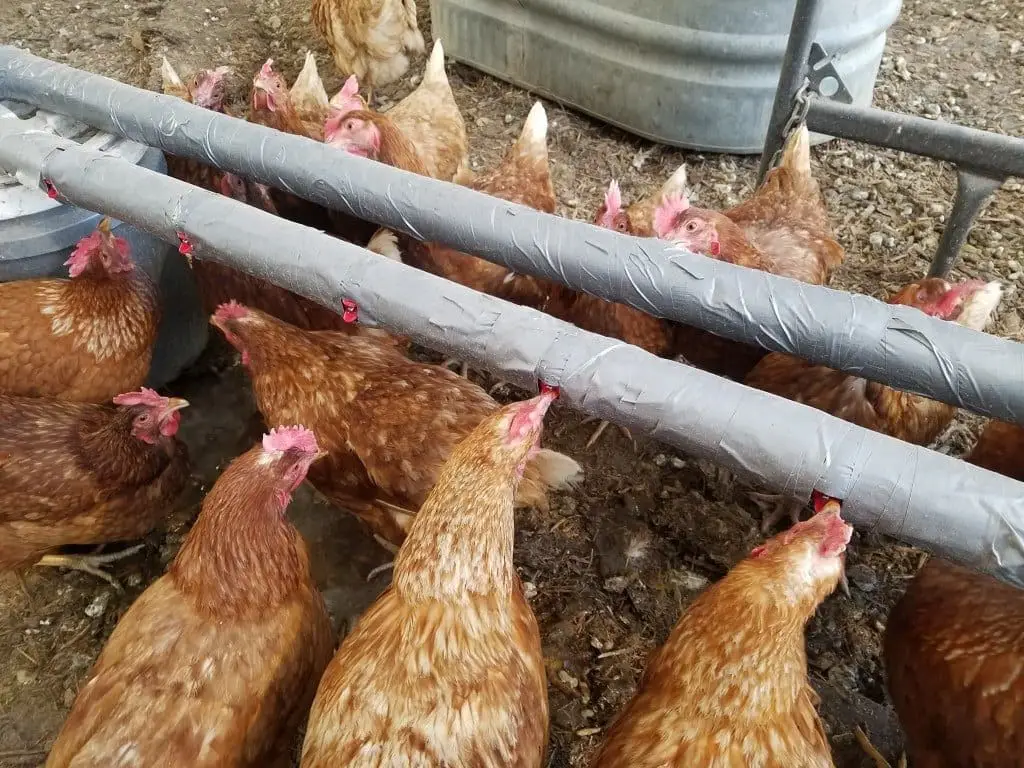I’ve tried all kinds of schemes for providing water for chickens during the winter. This year, I think I’m finally close to a satisfactory design.
This design owes a lot of credit to a similar system described at Green Machine Farm. I’m using a very similar setup with an aquarium pump, a tank heater, an insulated tank, and a recirculating loop. Besides the fact that I’m using a bigger tank and more insulation, my design differs in that I’m using horizontal nipples instead of vertical nipples. The horizontal nipples spill more water, but they have a tremendous cold-weather advantage: they don’t store any water inside the body of the fitting so they are unlikely to plug.

I’m not sure how cold it has been during this recent cold snap. I know it has been below -10F but I haven’t been watching the thermometer too closely. The nipples form a little ice overnight but if I bring a gallon of hot water from the house and quickly wipe off each nipple, the water is flowing again immediately.

This system seems like it should work well, but there are a few vulnerabilities. First, if the power goes out or a cord is unplugged, the system will freeze up. Second, if the pump or heater were to fail, the system would freeze up. Third, if the system were to run dry the pump would burn out or the heater might melt the tank. The third situation is preventable by frequent monitoring, but it seems foolish to think that I’ll be able to avoid either of the first two situations indefinitely. At -10 or -20, it wouldn’t take long to freeze solid. I know that whatever I build, I eventually repair. So when I repair this system, I’ll add a loop of heat trace under the insulation along the pipeline. That will allow me to thaw the pipes when the inevitable freeze up occurs, potentially saving lots of downtime.

Now if only I could figure out a system to take the chill off my nest boxes, I’d be all set. Unless we collect eggs hourly, we end up with lots of frozen eggs.


5 thoughts on “Frost Free Chicken Water”
Thanks for posting your watering system. I’m working on building my own and was searching the net for ideas. Nice to see that my idea is not insane. How has it been working for you now that it’s been a couple of years since the build?
It has been a reliable system. As stated in the post, below -10F the nipples ice over a little, requiring a rag dipped in warm water to be wiped over each. The biggest problem has been finding good quality nipples. They just don’t seem as well made as the vertical nipples, so I had quite a few leaks and always needed a lot of spares.
Did you mount good drain points? If you lose power you could go empty it to prevent a monster ice cube. Other ideas you may have already thought of –
1. Drain it and shut down every night to save power (not sure how much it’s drawing) I know a chore like that could be a pain in the rear.
2. An alternative to the heat trace – attach the run of pipe to the main reservoir with a camlock fitting so that if it freezes overnight you have an easy way to pop off the waterer and take it inside for thawing. Of course if it’s frozen hard you’d need to thaw the camlock, but that’s easier than working down the whole pipe.
Draining isn’t too bad, just unwrap some insulation and pull the heater hose off the barbed fitting. But I’d rather not drain it. I don’t have much water on the front half of the farm, just whatever is collected in the cistern and anything else needs to be trucked in. The house well doesn’t have much capacity at all. Running the 500W heater in the tank seems to be more than sufficient; there’s never been the slightest hint of ice in the tote though this recent cold snap, so I think I could withstand 24 hours of heater malfunction (but I can’t withstand any pump malfunction).